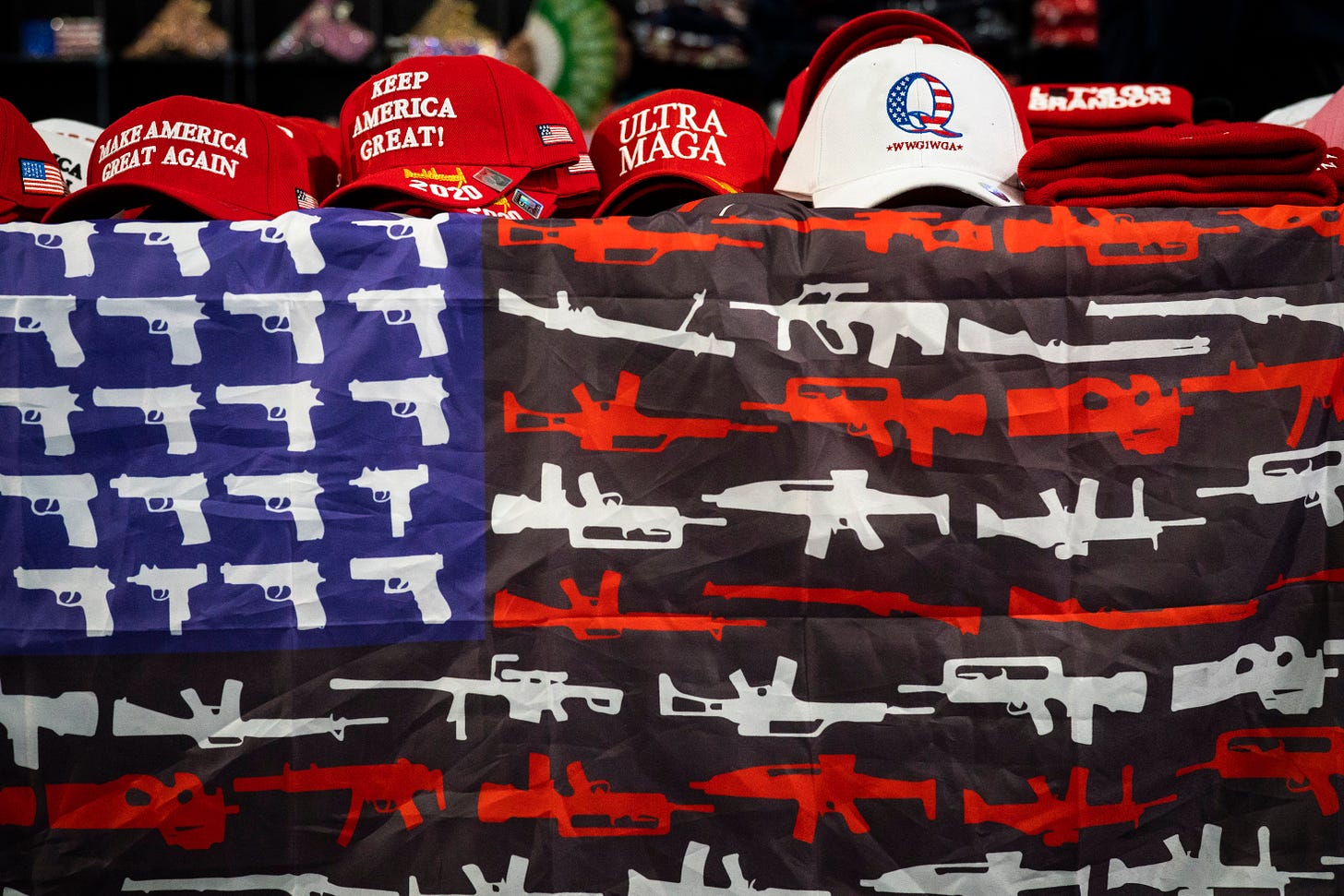We Need to Talk About Right-Wing Violence on Election Day
Want to win at the polls? Scare your opponents away from them.

IN HIS INSTANTLY INFAMOUS INTERVIEW on Sunday with Maria Bartiromo of Fox Business, Donald J. Trump floated the idea of using the military against American citizens who oppose him. But some commentators missed that his remarks about “the enemy from within,” “radical left lunatics,” and “very bad,” “sick” people came in response to a question specifically about whether Election Day would be peaceful. Trump made it sound like the danger of violence on Election Day comes from people who are “not from the side that votes for Trump.”
The reality is the opposite: Most of the threats of election-related violence are coming from the political right. And being targeted are not just election officials but also ordinary voters.
Let’s start with the big picture. In general, our elections are safe. As Allison Anderman of the Brennan Center puts it, “events of violence” are rare—but they are “closely covered by the media” in a way that drives “public perceptions that political violence is imminent.” Those perceptions are clearly also being driven by the continuing rhetoric from Republicans of refusing to accept that Donald Trump lost the 2020 election and refusing to promise to concede if he loses this year. According to a Quinnipiac poll conducted in late August, 73 percent of likely voters report that they are either very or somewhat concerned that there will be politically motivated violence following the outcome of the 2024 presidential election.
And there is no shortage of disturbing stories. According to one report out of Ohio, a sheriff by the name of Bruce D. Zuchowski made a despicable Facebook post suggesting that voters mark down the addresses of people displaying “the Flip-Flopping, Laughing Hyena” (presumably meaning Kamala Harris) yard signs. Sixty individual complaints were filed against him alleging criminal voter intimidation, forty-five by Ohio residents. Zuchowski is now under investigation by the Ohio attorney general and Ohio Bureau of Criminal Investigation.
In reality, voter suppression is much more likely to occur through intimidation than through violence. Republicans are recruiting poll monitors from suburban areas to stand around and observe the vote in Democratic cities, prompting election experts to worry about voter safety. (Such shenanigans were hampered by a 1982 federal consent decree requiring prior court approval of poll-watching activities to ensure they weren’t discriminatory, but it was lifted in 2018 after the Republican National Committee sued.) This year, Republicans’ “Protect the Vote” project plans to deploy 100,000 volunteers and attorneys, mostly in battleground states, to sign up and train people to be poll monitors. The RNC is also working with outside Trump-aligned groups.
No wonder the Justice Department has made public its concern over reports of armed vigilantes in ballistic vests watching people at ballot boxes in Arizona.
Threats, intimidation, and coercion are illegal under the federal Voting Rights Act, even if they don’t succeed. But “success” might be achieved simply by creating the impression among the public—especially among black Americans, for whom there’s a long history of racism around voting—that voting is so great a danger that it’s not worth trying. Said Jonathan Diaz of the nonpartisan Campaign Legal Center: “When you think about [tens of thousands] of potential poll observers or poll watchers going from a suburban county into a more urban area, ostensibly to monitor for evidence of voter fraud, [a] major concern[] . . . is the potential for voter intimidation, especially when you consider the racial dynamics of some of these communities and some of the accusations that were made in the wake of the 2020 election.”
Bear in mind, too, that nearly one in five polling places in the United States is a church, and hostility towards places of worship has been rising in America. Last August, the U.S. attorney for Ohio issued a warning “about best practices for preventing targeted violence and guidance for how houses of worship can protect themselves against acts of vandalism and arson.” On Tuesday, DOJ announced it will be monitoring compliance with the VRA in Portage County, Ohio, after “voters raised concerns about intimidation resulting from the surveillance and the collection of personal information regarding voters, as well as threats concerning the electoral process.” Meanwhile, authorities in Paris, Texas, opened an investigation last week into a suspicious fire of the Love Tabernacle Church on September 29, in which the perpetrators left racist graffiti stating, “Leave Town [N-Word].”
THE INJECTION OF VIOLENCE into elections has grave implications for democracy. In their seminal work How Democracies Die, Steven Levitsky and Daniel Ziblatt write that a political party’s endorsement of political violence is one of the historical hallmarks of a democracy under threat. Said Ziblatt in an interview: “Political violence is a really bad sign . . . that’s certainly connected to fascism.” He explained:
Those who threatened political violence suddenly gain more influence. The way that politics is supposed to work in a democracy is that politicians are supposed to make decisions based on what they think their constituents want, or what they think is the right thing to do. If they don’t do what the voters want, the voters vote him out. But if you have violence, the shadow violence hanging over these decisions, this is clearly not democratic. And it’s a basic violation of key principles of human rights and so on. And so I think it’s really, really very frightening.
In 2020, sworn witness affidavits—like this very detailed one from Michigan—and interviews revealed that black voters in many locations were uncomfortable with how poll challengers, generally white Republicans, treated them—baselessly harassing them and accusing them without evidence of wrongdoing. Given Trump’s violent rhetoric and the millions of MAGA loyalists who have been led to believe Trump’s Big Lie about 2020 having been stolen, we should be prepared for this year to be far worse.



